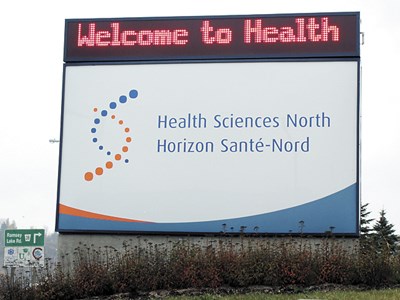In mid-October, the number of alternate level of care (ALC) patients at Health Sciences North's acute care site — the Ramsey Lake Health Centre — hovered at a little over 100.
As of Dec. 6, those numbers are down to 77. ALC patients are those who no longer need acute care, but remain in hospital while waiting for placement in a long-term care home or other community care.
At the same time, there are nine patients waiting in the emergency department for an inpatient bed. A few months ago, that number had crept up into the high 20s, causing emergency room wait times to skyrocket.
How are these reductions possible? The answer, at least in part, stems from some of the recommendations in the report from peer review of the hospital, which was released in October.
The peer review, led by Hamilton Health Sciences CEO Murray Martin, stated the hospital should aim to reduce its average length of stay to 10 per cent better than the national average.
This goal has now nearly been met, said David McNeil, the hospital's vice-president of clinical programs.
“We've seen significant reductions in our acute length of stay over the last six weeks,” he said. “That's been through a concerted effort by our teams to move people out.”
Another recommendation was to reduce the number of ALC patients being designated as being destined for long-term care while in hospital.
Once a patient receives this designation, they're generally in the hospital for a long period of time while they wait for placement in a long-term care facility.
McNeil, along with North East Community Care Access Centre (CCAC) senior director of client services Frankie Vitone have been personally supervising these designations.
“Only cases where Frankie and myself say that 'No, that patient really does need to go to a long-term care facility, and the option of home, with both public and private resources, isn't an option that can be achieved,' will we designate long-term care,” he said.
“We've reduced through that process, in the last seven to eight weeks, our ALC designation rate from about five per week to about a little less than two per week.”
At the same time, the hospital and the North East CCAC have been working together to re-launch the Home First program, another one of the peer review's recommendations.
The Home First program allows hospital patients to return home with enhanced home care supports.
“I think the proof is in the pudding,” Vitone said. “We're starting to see results of working together.”
The key to these goals has been to manage the public's expectations about who can stay in the hospital, she said.
“I think the message is starting to become very clear for people that acute care beds are needed for acute care clients, and when people come for acute care, then the goal is to be discharged.”
Beyond the implementation of the peer review recommendations, another factor leading to the reduction of ALC patients could be the opening last month of the 82-unit Lepokoti assisted-living facility at Finlandia Village.
Vitone said the facility may be helping seniors with lower needs to stay healthy, and out of long-term care facilities and the hospital.
The partners are monitoring the situation closely to make sure these plans are working the way they should be, McNeil said.
“Now where we're going to have to watch to see if these patients are coming back sooner than we would expect them to come back into the hospital,” he said.
“That's information that we're going to have to watch over time as we test that model out.
“If we're pushing people into the community, and they can't sustain themselves, and they're just coming back to the hospital, then you really haven't achieved anything. But we haven't seen that yet.”
While what the partners are doing has been difficult, it's dangerous to have an overcrowded hospital, McNeil said.
“There is clear evidence on that.”
The reduction in the ALC numbers has had a positive impact on the hospital, he said.
For example, the length of time it takes to get an inpatient bed at Health Sciences North has improved by 20 hours over the past month, McNeil said.
“We're basically at the provincial average now.”
The partners have a long way to go, though. The peer review report stated the hospital should aim to have ALC patients make up only 10 per cent of its acute care beds, or about 30 ALC patients, within a few years.
Health Sciences North is also working to close the ALC unit at the former Memorial Hospital site by Jan. 27. The number of patients in the unit has already been reduced from 30 to 21 over the last few weeks.
Vitone said these patients have been given a priority status to be placed in long-term care facilities.
“So far, we've been meeting our target every week,” she said. “The vacancies are coming up and are matching to the clients.”
Join Sudbury.com+
- Messages
- Post a Listing
- Your Listings
- Your Profile
- Your Subscriptions
- Your Likes
- Your Business
- Support Local News
- Payment History
Sudbury.com+ members
Already a +member?
Not a +member?
Sign up for a Sudbury.com+ account for instant access to upcoming contests, local offers, auctions and so much more.
